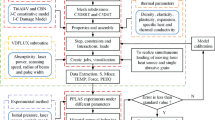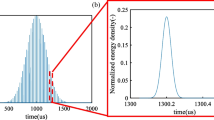Abstract
Laser thermal shock (LTS)-assisted grinding is a novel technology for processing ceramics. However, the material removal mechanism in LTS-assisted grinding has not been studied extensively, hindering the sufficient development of its potential. This paper focuses on the material removal mechanism in LTS-assisted grinding by investigating the material removal behavior in LTS-assisted scratching of yttria-stabilized tetragonal zirconia polycrystal (Y-TZP). In order to reveal the different material removal behaviors between the Y-TZP specimen surfaces with and without LTS, the scratch characteristics were investigated and compared in terms of hardness of the ceramic surface, scratching force ratio (SFR), and scratch morphology. Compared with the surface without LTS, the grooves on the surface with LTS were deeper, the SFR was larger, and the hardness of surface decreased. These results indicate that the grindability of Y-TZP significantly improved from the assistance of the LTS. As further evidence, prominent marks of grain spalling were found in the scratch grooves on the surface with LTS and the material removal volume increased. These results indicate that the cutting efficiency of the tool improved after the surface was treated with LTS. Furthermore, the plastic ridges and marks of grain spalling on the surface assisted with LTS indicate the existence of ductile-brittle mixed mode. This is significant and beneficial for ceramics grinding due to its improved surface integrity and large material removal rate.
Similar content being viewed by others
References
Horvath M, Kundrak J, Mamalis A, Gyani K (2002) On the precision grinding of advanced ceramics. Int J Adv Manuf Technol 20(4):255–258
Chen J, Shen J, Huang H, Xu X (2010) Grinding characteristics in high speed grinding of engineering ceramics with brazed diamond wheels. J Mater Process Technol 210(6):899–906
Agarwal S, Rao PV (2008) Experimental investigation of surface/subsurface damage formation and material removal mechanisms in SiC grinding. Int J Mach Tools Manuf 48(6):698–710
Kumar M, Melkote S, Lahoti G (2011) Laser-assisted microgrinding of ceramics. CIRP Ann Manuf Technol 60(1):367–370
Feng P, Liang G, Zhang J (2014) Ultrasonic vibration-assisted scratch characteristics of silicon carbide-reinforced aluminum matrix composites. Ceram Int 40(7):10817–10823
Samant AN, Dahotre NB (2009) Laser machining of structural ceramics—a review. J Eur Ceram Soc 29(6):969–993
Desa O, Bahadur S (1999) Material removal and subsurface damage studies in dry and lubricated single-point scratch tests on alumina and silicon nitride. Wear 225:1264–1275
Zhang B, Zheng X, Tokura H, Yoshikawa M (2003) Grinding induced damage in ceramics. J Mater Process Technol 132(1):353–364
Zhang X, Chen G, An W, Deng Z, Zhou Z (2014) Experimental investigations of machining characteristics of laser-induced thermal cracking in alumina ceramic wet grinding. Int J Adv Manuf Technol 72(9–12):1325–1331
Sivakumar R, Jones MI, Hirao K, Kanematsu W (2006) Scratch behavior of SiAlON ceramics. J Eur Ceram Soc 26(3):351–359
Kanematsu W (2004) Subsurface damage in scratch testing of silicon nitride. Wear 256(1):100–107
Kun Lee S, Tandon R, Readey MJ, Lawn BR (2000) Scratch damage in zirconia ceramics. J Am Ceram Soc 83(6):1428–1432
Subhash G, Bandyo R (2005) A new scratch resistance measure for structural ceramics. J Am Ceram Soc 88(4):918–925
Gu W, Yao Z, Liang X (2011) Material removal of optical glass BK7 during single and double scratch tests. Wear 270(3):241–246
Azizi A, Mohamadyari M (2015) Modeling and analysis of grinding forces based on the single grit scratch. Int J Adv Manuf Technol 78:1223–1231, 1–9
Rebro PA, Shin YC, Incropera FP (2004) Design of operating conditions for crackfree laser-assisted machining of mullite. Int J Mach Tools Manuf 44(7):677–694
Ding H, Shin YC (2013) Improvement of machinability of Waspaloy via laser-assisted machining. Int J Adv Manuf Technol 64(1–4):475–486
Shen X, Lei S (2011) Experimental study on operating temperature in laser-assisted milling of silicon nitride ceramics. Int J Adv Manuf Technol 52(1–4):143–154
Peng Y, Liang Z, Wu Y, Guo Y, Wang C (2012) Effect of vibration on surface and tool wear in ultrasonic vibration-assisted scratching of brittle materials. Int J Adv Manuf Technol 59(1–4):67–72
Zhang X, Chen G, An W, Deng Z, Liu W, Yang C (2014) Experimental study of machining characteristics in laser induced wet grinding silicon nitride. Mater Manuf Process 29(11–12):1477–1482
Kelly JR, Denry I (2008) Stabilized zirconia as a structural ceramic: an overview. Dent Mater 24(3):289–298
Backer W, Marshall E, Shaw M (1952) The size effect in metal cutting. Trans ASME 74(1):61
Ren J, Hua A (2011) The theory of grinding. Publishing House of Electronics Industry
Petit F, Ott C, Cambier F (2009) Multiple scratch tests and surface-related fatigue properties of monolithic ceramics and soda lime glass. J Eur Ceram Soc 29(8):1299–1307
Agarwal S, Rao PV (2013) Predictive modeling of force and power based on a new analytical undeformed chip thickness model in ceramic grinding. Int J Mach Tools Manuf 65:68–78
Xu HH, Jahanmir S, Ives LK (1996) Material removal and damage formation mechanisms in grinding silicon nitride. J Mater Res 11(07):1717–1724
Ben LCGHW, Renke GDTXK, Dongjiang W (2010) Experimental study of single-tip scratching on potassium dihydrogen phosphate single crystal [J]. J Mech Eng 13:027
Marinescu ID, Hitchiner MP, Uhlmann E, Rowe WB, Inasaki I (2006) Handbook of machining with grinding wheels. CRC Press
Liang Z, Wang X, Wu Y, Xie L, Liu Z, Zhao W (2012) An investigation on wear mechanism of resin-bonded diamond wheel in elliptical ultrasonic assisted grinding (EUAG) of monocrystal sapphire. J Mater Process Technol 212(4):868–876
Zhang W, Subhash G (2001) An elastic–plastic-cracking model for finite element analysis of indentation cracking in brittle materials. Int J Solids Struct 38(34):5893–5913
Larchuk T, Conway J, Kirchner H (1985) Crushing as a mechanism of material removal during abrasive machining. J Am Ceram Soc 68(4):209–215
Author information
Authors and Affiliations
Corresponding authors
Rights and permissions
About this article
Cite this article
Xu, S., Yao, Z. & Zhang, M. Material removal behavior in scratching of zirconia ceramic surface treated with laser thermal shock. Int J Adv Manuf Technol 85, 2693–2701 (2016). https://doi.org/10.1007/s00170-015-8098-7
Received:
Accepted:
Published:
Issue Date:
DOI: https://doi.org/10.1007/s00170-015-8098-7




